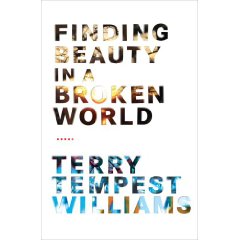| |
Finding Beauty In A Broken World
(Source:) "Piecing it all together"
By Art Gould
Special to The Anniston Star, Alabama, USA
10 May 2009
Finding Beauty In A Broken World
By Terry Tempest Williams
Mosaic is an intricately constructed art form of great perspective beauty enjoyed clearly at a distance. Mosaic is a metaphor for the way the tessera, the pieces of our lives, fit together to form a singular vision. Mosaic is an adjective describing significant patterns in the natural world. Mosaic, in all its manifestations, is the central image in Terry Tempest Williams's search for beauty in a shattered world.
Williams, the Anne Clark Tanner Scholar in Environmental Humanities at the University of Utah, employs mosaic construction to signify the intricate and sometimes obtuse connections between our daily lives and the universal designs of nature.
Not only that . . . Williams' 12th book of popular sociology focuses on the mass murder of the Tutsi people in Rwanda during the 1994 genocide.
While the author compiles the horrors of those times in Rwanda, she compares them to the recent systematic extermination of American prairie dogs in the western United States.
Like red-stained tessera, the remnants of lost lives come together to compose a vast and shocking mosaic of contemporary life. Here, however, the pieces of the mosaic are not multi-colored bits of marble or glass but the bleached bones of the victims.
The disparate parts of the book making up a complete picture include: Mosaics, prairie dogs, pieces of a community, public land policies, family, the tools of life, the unfortunate victims of world-wide genocide, and the words themselves . . . The tessera of the writer.
But how does Williams find beauty in a toxic landscape? Like the American naturalist Henry David Thoreau, by ordering the details of everyday life and by accounting for the truth of our actions.
"Mosaic became the way I perceived the world: Break it up and re-create a unity. Part of the nature of man is to recompose a unity that has been broken. In mosaic, I re-create an order out of shards," Williams quotes the contemporary Italian mosaic artist Marco de Luca, and Williams wants us to take his words to heart. They are the theme of her book.
Williams' journey of discovery opens with an illuminating story of her experience in a mosaic studio in Ravenna, Italy. There she learns to use the tools of the art, the hammer and the hardie, to cut the colored glass, stone and marble chips she uses to create her own mosaic. But she is talking about something far beyond her art work.
Ravenna is the jumping-off spot for the book, as Williams departs the safe arena of the studio and begins her search for the world's hidden beauty in very dangerous places.
Writing about killing prairie dogs, the "varmints" of the west, Williams strikes a sinister chord foreshadowing the horrors that she will encounter in Rwanda, where she comes face-to-face with the forces of genocide.
Williams is at the heart of darkness in Rwanda following the 1994 genocide of the Tutsi people. She is surrounded by countless human remains.
For Williams, the bones are not inherently beautiful tessera. They are objects of horror. But in the end, she finds a rare, sad beauty in what the bones tell her: The truth about what happened to the victims. No matter how bitter its message, truth's abstract beauty is the overpowering reality of Williams's pensive journey.
(Art Gould is a former newspaper reporter and book publisher. He lives in Anniston, Alabama, USA)
Price: $26 |




